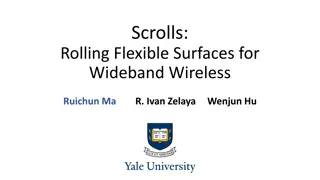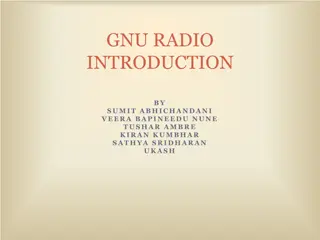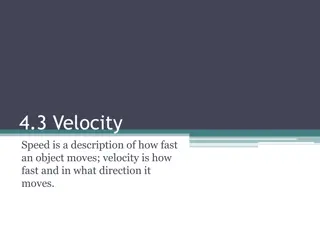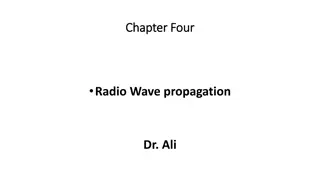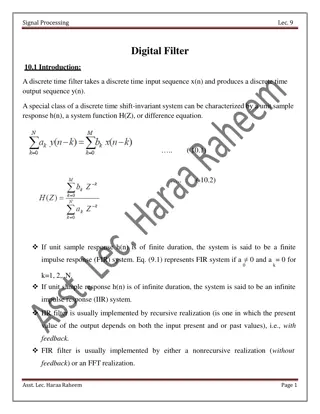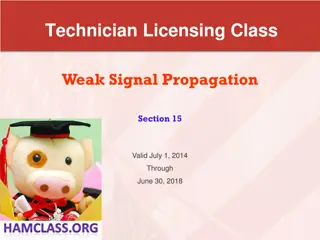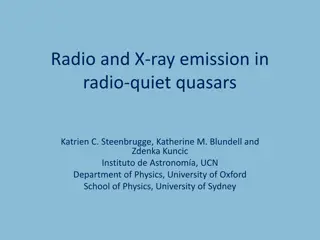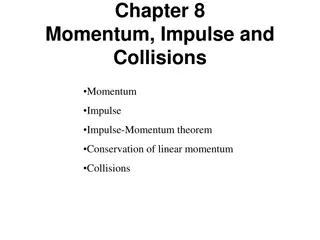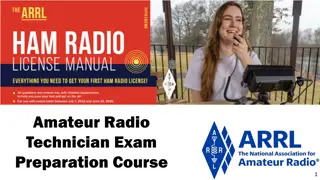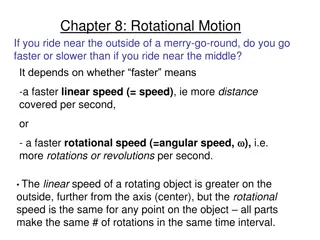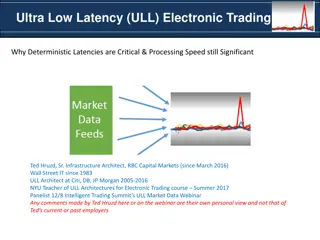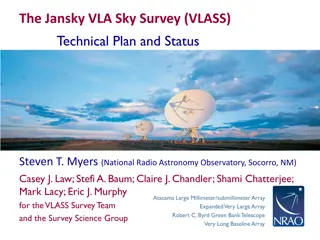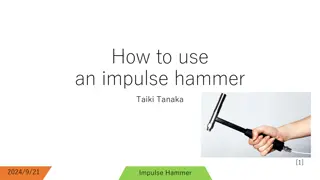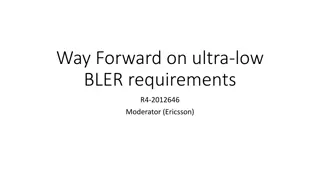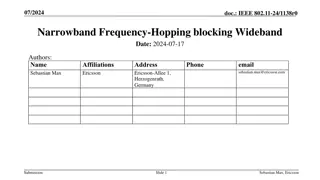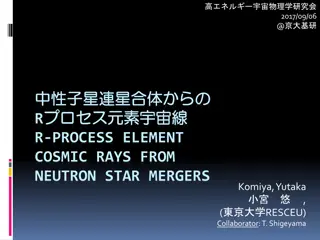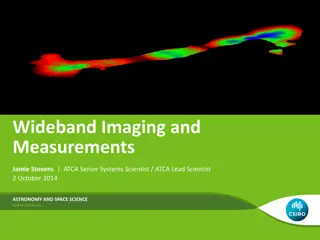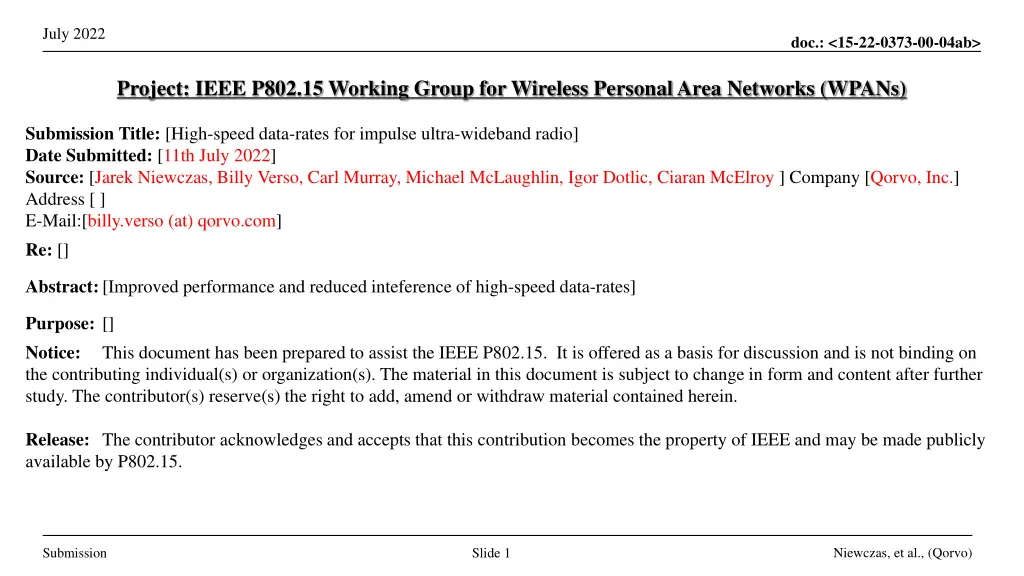
Enhancing High-Speed Data Rates for Wireless Personal Area Networks
Explore the advancements in high-speed data rates for wireless personal area networks, focusing on impulse ultra-wideband radio technology. This submission to IEEE P802.15 Working Group outlines methods to improve performance and reduce interference, with a proposed solution including pulse hopping, additional channels, and enhanced reliability. The document discusses the introduction of a new data mode achieving 31Mbps and the implementation of faster rates up to 62Mbps.
Download Presentation

Please find below an Image/Link to download the presentation.
The content on the website is provided AS IS for your information and personal use only. It may not be sold, licensed, or shared on other websites without obtaining consent from the author. If you encounter any issues during the download, it is possible that the publisher has removed the file from their server.
You are allowed to download the files provided on this website for personal or commercial use, subject to the condition that they are used lawfully. All files are the property of their respective owners.
The content on the website is provided AS IS for your information and personal use only. It may not be sold, licensed, or shared on other websites without obtaining consent from the author.
E N D
Presentation Transcript
July 2022 doc.: <15-22-0373-00-04ab> Project: IEEE P802.15 Working Group for Wireless Personal Area Networks (WPANs) Submission Title: [High-speed data-rates for impulse ultra-wideband radio] Date Submitted: [11th July 2022] Source: [Jarek Niewczas, Billy Verso, Carl Murray, Michael McLaughlin, Igor Dotlic, Ciaran McElroy ] Company [Qorvo, Inc.] Address [ ] E-Mail:[billy.verso (at) qorvo.com] Re: [] Abstract: [Improved performance and reduced inteference of high-speed data-rates] Purpose: [] Notice: the contributing individual(s) or organization(s). The material in this document is subject to change in form and content after further study. The contributor(s) reserve(s) the right to add, amend or withdraw material contained herein. This document has been prepared to assist the IEEE P802.15. It is offered as a basis for discussion and is not binding on Release: The contributor acknowledges and accepts that this contribution becomes the property of IEEE and may be made publicly available by P802.15. Niewczas, et al., (Qorvo) Submission Slide 1
July 2022 doc.: <15-22-0373-00-04ab> PAR Objective Safeguards so that the high throughput data use cases will not cause significant disruption to low duty-cycle ranging use cases Interference mitigation techniques to support higher density and higher traffic use cases Other coexistence improvement Backward compatibility with enhanced ranging capable devices (ERDEVs) Improved link budget and/or reduced air-time Proposed Solution (how addressed) High-speed data-rates reduce the packet length thus reduce the interference. Pulse hopping additionally reduces the probability of high pulse collision rates between different users. ... same as above ... same as above ... same as above Additional channels and operating frequencies Improvements to accuracy / precision / reliability and interoperability for high-integrity ranging Reduced complexity and power consumption ... same as above Hybrid operation with narrowband signaling to assist UWB Enhanced native discovery and connection setup mechanisms Sensing capabilities to support presence detection and environment mapping Low-power low-latency streaming Higher data-rate streaming allowing at least 50 Mbit/s of throughput Support for peer-to-peer, peer-to-multi-peer, and station-to- infrastructure protocols Infrastructure synchronization mechanisms ... same as above ... same as above Niewczas, et al., (Qorvo) Submission Slide 2
July 2022 doc.: <15-22-0373-00-04ab> Introduction IEEE standard 802.15.4z introduced a new PRF256 (MHz) -based 31Mbps data mode. One symbol, representing one encoded data bit, consists of: 4 encoded and scrambled G0 pulses, followed by a silence gap, then encoded and scrambled G1 pulses, and again a silence gap. The pulses are transmitted 2ns apart (Tchip), for a total symbol duration of 32ns. The gap length of 8ns provides some protection against near multi-path reflections. Due to as many as 8 pulses per one data bit, the 31Mbps scheme is very robust and performs well in all multi-path conditions. Niewczas, et al., (Qorvo) Submission Slide 3
July 2022 doc.: <15-22-0373-00-04ab> New high-speed data-rates The faster rates, including 62Mbps and 125Mbps modes, can also be implemented using BPSK, therefore the number of pulses per symbol will get reduced (assuming constant PRF of 256MHz). The pulses may form symbols using several different grids. A number of options is presented below. Example 62Mbps symbol using grid option-3 : Niewczas, et al., (Qorvo) Submission Slide 4
July 2022 doc.: <15-22-0373-00-04ab> The problem with a TWO-PATH channel In indoor environments, multiple reflections usually occur (off walls, floor, objects etc). While more reflections typically improve the receiver s performance (by providing it with more energy when combined together), some channel types are problematic. The most difficult channel type is where there are only two paths present, both having similar power, phase difference between them being either close to 0 or 180-degrees and the delay between them such that all the pulses collide. In case of 62Mbps mode using option-2 grid, such delay could be 8ns (or a multiple of 8ns). In the event of such collisions, pulses may cancel out (depending their polarity and scrambling bits). The consequence of this is degraded performance. Niewczas, et al., (Qorvo) Submission Slide 5
July 2022 doc.: <15-22-0373-00-04ab> The problem with a TWO-PATH channel Such situations are not rare. In indoor environments, with UWB devices attached to the body there typically are 2-3 paths having significant power. The distance between them, which depends for example on the distance from the wall, may be exactly 8ns or 16ns. 8ns difference translates into +2.4m of the extra distance for the second path. The 2.4m-delayed path could also be the path bouncing off the ground or ceiling. For 62Mbps option-2 , full collisions occur when the two paths are 8ns (or multiple) apart, while with option-3 , the two paths would need to be 16ns apart (or multiple), therefore making it less likely to occur than for option-2 (or option-1 ). Niewczas, et al., (Qorvo) Submission Slide 6
July 2022 doc.: <15-22-0373-00-04ab> TWO-PATH performance (62Mbps/125Mbps) The performance impact of the collisions is shown below. The 62Mbps mode (grid option-2 ) may suffer 3-4dB in performance loss. The 125Mbps mode (also grid option-2 ) suffers much more for delays near 8ns, the 125Mbps mode fails to reach 100% PER irrespectively of RSL. The presented results are obtained using RAKE-like receiver. Niewczas, et al., (Qorvo) Submission Slide 7
July 2022 doc.: <15-22-0373-00-04ab> Random hopping To reduce the interference impact, the symbols could use pulse position hopping. The hopping technique has been previously used in 802.15.4a data-modes. Hopping may be either pseudo-random (for example determined by the scrambling bits) or follow a pre-defined pattern. For example, in 125Mbps mode with option-2 , there is an 8ns-long burst containing G0 and G1 pulses. When randomizing pulse positions in such a burst, the pseudo-randomly generated pattern could use one of four possible hopping patterns: [G0 G1 - -] or [- G0 G1 -] or [- - G0 G1] or [G0 - - G1]. Please note that the shown G0/G1 mapping is just an example applicable to a convolutional encoder with a coding rate of . For other encoders (like LDPC), the hopping scheme will remain the same except that pulses may represent different encoded bits. The pseudo-random hopping performs somewhat worse than fixed-grid hopping, because the pseudo- random algorithm can generate multiple identical hopping positions in the row, which will cause consecutive 100% pulse collisions, and could result in decoding failure (especially with weaker convolutional decoders). Niewczas, et al., (Qorvo) Submission Slide 8
July 2022 doc.: <15-22-0373-00-04ab> Fixed-grid hopping The pre-defined hopping scheme could be such that it guarantees that there will be no consecutive 100% pulse collisions at any of the selected delays between the reflected paths. For example, the grid below minimizes the effect of TWO-PATH collisions at 8ns/16ns/24ns: [G0 G0 - - - - G1 G1 - G0 G0 - G1 - - G1]. While minimizing collisions at the critical delays, it however produces 62% pulse collisions at other delays (12ns and 20ns). PATH-1@0ns: AA----BB-CC-D--DEE----FF-GG-H--HII----JJ-KK-L--L (collision rate with 0ns path: ) PATH-2@8ns: AA----BB-CC-D--DEE----FF-GG-H--HII----JJ-KK-L--L (50%) PATH-2@16ns: AA----BB-CC-D--DEE----FF-GG-H--HII----JJ-KK-L--L (25%) PATH-2@24ns: AA----BB-CC-D--DEE----FF-GG-H--HII----JJ-KK-L--L (50%) but: PATH-2@12ns: AA----BB-CC-D--DEE----FF-GG-H--HII----JJ-KK-L--L (62%) PATH-2@20ns: AA----BB-CC-D--DEE----FF-GG-H--HII----JJ-KK-L--L (62%) Niewczas, et al., (Qorvo) Submission Slide 9
July 2022 doc.: <15-22-0373-00-04ab> Optimized fixed-grid hopping While the collision impact with default grids is the most significant at 8/16/24ns apart, performance loss due to collisions at other delays can also be significant (depends on the grid used). It is possible to use a hopping pattern, which guarantees that there will be no bad delays in a certain range, which can be considered practical. For example, the following 62Mbps mode grid (spanning over two symbols, or 32ns), minimizes pulse collisions for any delay up to 28ns apart: [G0 G0 - - - - G1 G1 - G0 - G0 - G1 G1 -], where - is a silence gap. For 125Mbps mode, the same 32ns grid can be rewritten, here, spanning over 4 symbols: [G0 G1 - - - - G0 G1 - G0 - G1 - G0 G1 -] (Note: different colours represent different symbols) This grid provides guaranteed up to 50% collision rate for all delays between paths up to 30ns. For 2/8/24/30ns, the collision rate is lower at 37%. The fixed pattern hopping generally provides more consistent performance across various delays between the two paths. Other optimized grids are also possible, and the grids patterns may be longer than 32ns. Niewczas, et al., (Qorvo) Submission Slide 10
July 2022 doc.: <15-22-0373-00-04ab> Random vs. optimized grid hopping @125Mbps Niewczas, et al., (Qorvo) Submission Slide 11
July 2022 doc.: <15-22-0373-00-04ab> None vs. optimized grid hopping @125Mbps Niewczas, et al., (Qorvo) Submission Slide 12
July 2022 doc.: <15-22-0373-00-04ab> None vs random hopping @62Mbps Niewczas, et al., (Qorvo) Submission Slide 13
July 2022 doc.: <15-22-0373-00-04ab> Random vs optimized grid hopping @62Mbps Niewczas, et al., (Qorvo) Submission Slide 14
July 2022 doc.: <15-22-0373-00-04ab> Symbol pulse hopping (IEEE-CM1) Hopping makes little imapct on IEEE-CM1 channels. Niewczas, et al., (Qorvo) Submission Slide 15
July 2022 doc.: <15-22-0373-00-04ab> Conclusion The scenarios where two paths have similar strength, may result in degraded performance, if the distance between them is a multiple of symbol (or of a repetitive pulse section) length. The performance loss may be especially significant with the 125Mbps option. The simplest method of eliminating this problem is by introducing pulse hopping. The fixed, optimized grids provide better performance than random hopping and the performance is consistent across a wide range of delays between the paths of the TWO-PATH channel. The hopping can also reduce interference to other users (even ranging or sensing packets). Recommendations: consider 62Mbps and 125Mbps data rate modes using fixed, optimized pulse hopping grids. if hopping is not used, consider using option-3 grid for 62Mbps and option-2 for 125Mbps to maximize the delay range, which does not suffer from 100% pulse collision. Niewczas, et al., (Qorvo) Submission Slide 16

